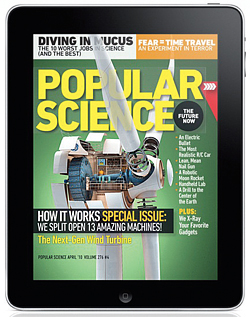Apple's iPad and the Future of Video Media

In the first 28 days, sales of Apple's iPad soared past a million. After two months, the device remains sold out in retail stores throughout the world. The conservative naysayers were wrong again. Steve Jobs scored another home run—as usual.
This time, however, Job's radical new invention is more than about a single product from a single company. It's a new category of computer that should be of major interest to all of us in the media industries. I suspect it is the first step in a grand design that will offer a new multimedia distribution platform that could reinvent the journalism business and the way people consume media.
I know, I know. Many network television executives discount Apple because they claim Steve Jobs draws too deeply from their profits. Many traditional publishers view what happened to the music industry and don't trust Apple. They are wary of doing business with them.
Of the companies that have tried to develop media for the new iPad platform, early results have been disappointing—perhaps because their prices are out of line with what people are willing to pay for media in the midst of a recession. For this column, however, I'm taking a longer view about the future of media.
FROM THE ASHES

"The New York Times" on the Apple iPad There's little doubt now that many traditional media companies are broken. Huge numbers of jobs have been lost and the media craft has been devalued to the point where most participants are now working almost as slave labor. These days, a Pulitzer Prize won't buy its winner a cup of coffee.
From these ashes, Steve Jobs has introduced something new and it's certainly worth watching closely. No, it doesn't solve the economic perplexities of today's media environment, but it does offer a new way to communicate using a creative mix of words, pictures and sound. And, if you believe as I do, that quality will ultimately prevail in media, then the new platform offers hope.
First of all, what's so different about the iPad? Simple. It's a small, portable tablet that hits the holy grail of being the first ideal device for watching media anytime at anyplace. And when I say media, I mean traditional television, books, magazines, music—all media.
But its true power is combining these traditional forms of media into multimedia. Of course, multimedia is not new. What is new is the ability to interact with it with one's finger on a highly portable interactive pad that can be used anywhere. This brings enormous power to multimedia and creates completely new possibilities for storytelling.
There is a behind-the-scenes dispute going on between Apple and Adobe. Apple, who is pushing the HTML5 video codec for the iPad, banned Adobe's competing Flash technology on its devices. Developers are irate. Both sides are sniping at each other. But end users could care less. Sorry developers, but I have no doubt that Apple will win on this issue. They usually do.
Far more important, however, is what I expect (and hope) to be the next major shoe to drop. And that is very easy-to-use software for the creation of multimedia works for the iPad and similar devices. Software that will allow the end user to create his or her own works, without having to pay technical experts to do the job with convoluted coding methods.
There are indications that Apple is already working on it. Something like an "everyman's drag-and-drop" iWeb application for multimedia. With such software, end users could unleash their creativity to combine the written word with still and video images, sound clips, animation, graphics and any other media. Such inexpensive production could unleash a new wave of creative storytelling.
EXPERIMENTAL INNOVATION

"Popular Science" magazine on the Apple iPad In the meantime, some very creative people are already working with iPad. Sadly, I cannot count major news organizations like The New York Times or The Wall Street Journal in this group. The Times premiered with an embarrassingly inept iPad app that was actually full of typos and bad grammar. The WSJ, owned by Rupert Murdoch, is under delusions of grandeur, charging $17.99 a month for the iPad version, more than for the print version of the newspaper.
Far more interesting iPad experimenters are organizations like Newsy.com, which is located near the University of Missouri, the home of the nation's first school of journalism. Newsy has already hired some of the school's smartest graduates in an effort to change journalism.
Instead of covering breaking news, Newsy eyes a story and then grabs video clips from multiple sources across the political perspective to combine into a short video segment. As a result, the Newsy story combines work of diverse news production teams from around the world. Newsy is still finding its way, but its iPad app, built by winners of a local student design team, is outstanding—so outstanding that the company hired the students to refine it.
The iPad is a showplace for experimental innovation. It's not traditional television or print, but something new—a constantly changing combination of all previous media forms. Things will really get interesting when cheap software to create for it becomes available.
The story is still the thing—it always has been and always will be. It is the currency of communications between human beings. But the ways to tell stories constantly changes. And that change is what's so exciting about the iPad.
Frank Beacham is a New York City-based writer. Visit his website atwww.frankbeacham.comand his blog atwww.beachamjournal.com.
The professional video industry's #1 source for news, trends and product and tech information. Sign up below.
Frank Beacham is an independent writer based in New York.

